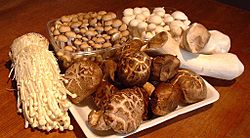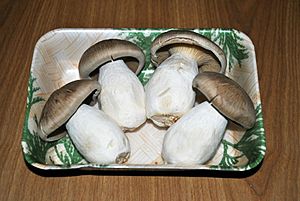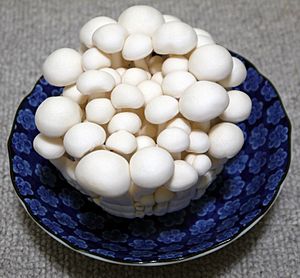Shimeji facts for kids
Shimeji (Japanese: シメジ, 占地 or 湿地) is a group of edible mushrooms native to East Asia, but also found in northern Europe. Hon-shimeji (Lyophyllum shimeji) is a mycorrhizal fungus and difficult to cultivate. Other species are saprotrophs, and buna-shimeji is now widely cultivated. Shimeji is rich in umami-tasting compounds such as guanylic acid, glutamic acid, and aspartic acid.
Species
Several species are sold as shimeji mushrooms. All are saprotroph except Lyophyllum shimeji.
- Mycorrhiza
- Hon-shimeji ([] Error: {{Lang}}: no text (help)), Lyophyllum shimeji
- The cultivation methods have been patented by several groups, such as Takara Bio and Yamasa, and the cultivated hon-shimeji is available from several manufacturers in Japan.
- Saprotroph
- Buna-shimeji ([] Error: {{Lang}}: no text (help), lit. beech shimeji), Hypsizygus tessellatus, also known in English as the brown beech or brown clamshell mushroom
- Hypsizygus marmoreus is a synonym of Hypsizygus tessellatus. Cultivation of Buna-shimeji was first patented by Takara Shuzo Co.,Ltd. in 1972 as hon-shimeji and the production started in 1973 in Japan. Now, several breeds are widely cultivated and sold fresh in markets.
- Bunapi-shimeji ([] Error: {{Lang}}: no text (help)), known in English as the white beech or white clamshell mushroom
- Bunapi was selected from UV-irradiated buna-shimeji ('hokuto #8' x 'hokuto #12') and the breed was registered as 'hokuto shiro #1' by Hokuto Corporation.
- Hatake-shimeji (ハタケシメジ), Lyophyllum decastes
- Shirotamogidake (シロタモギダケ), Hypsizygus ulmarius
- These two species had been also sold as hon-shimeji.
- Velvet pioppino (alias velvet pioppini, black poplar mushroom, Chinese: 茶樹菇/茶树菇), Agrocybe aegerita
Cooking
Shimeji should always be cooked: it is not a good mushroom to serve raw due to a somewhat bitter taste, but the bitterness disappears completely upon cooking. The cooked mushroom has a pleasant, firm, slightly crunchy texture and a slightly nutty flavor. Cooking also makes this mushroom easier to digest. It works well in stir-fried foods, as well as with wild game or seafood. Also it can be used in soups, stews and in sauces. When cooked alone, Shimeji mushrooms can be sautéed whole, including the stem or stalk (only the very end cut off), using a higher temperature or they can be slow roasted on a low temperature with a small amount of butter or cooking oil. Shimeji is used in soups, nabe and takikomi gohan.
See also
 In Spanish: Shimeji para niños
In Spanish: Shimeji para niños




